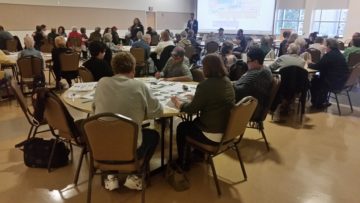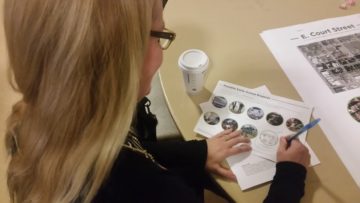By JAN LARSON McLAUGHLIN
BG Independent News
The neighborhood consultant group studying Bowling Green got another earful Tuesday evening. More than 60 city residents huddled at round tables to plot out ideas for their community.
They envisioned areas of their city with boulevard gardens, a market in the middle of student housing, bicycle paths, historic renovations and townhouses.
“We know there are a number of issues in the community we need to deal with,” said Adam Rosa, a member of the consultant group Camiros, from Chicago.
On Tuesday, Bowling Green residents were given areas to zero in on:
- East Court Street, where the focus was placed on improved sidewalks, boulevard gardens, bike paths, and historic renovations.
- Thurstin, Manville and Wooster streets, where the emphasis was put on mixed used development, improved pedestrian safety, improved business facades, and multi-family development.
- East Clough and Railroad Avenue where ideas included a rails-with-trails program, business incubator, artist studios, and brewery-taprooms.
- Third and High streets where the possibilities included a corner store, street trees, pocket park, and small lot single-family housing.
- Ridge Park area where the focus was on home renovation, possible townhouses, granny flats and more park activities.

Community Action Plan meeting
During the earlier public meeting, planners learned that Bowling Green residents felt the city’s assets were its history, culture, open space, parks, educational opportunities, commercial amenities, and neighborhood appearances.
On the down side, citizens felt problems existed with code enforcement, poor transportation which doesn’t accommodate walkers and bicyclists, conflicts between renters and homeowners, property maintenance specifically poor curb appeal, plus trash and noise.
Citizens identified opportunities for improvement as the addition of high-quality multi-family housing, open space improvements, bike and pedestrian accommodations and commercial redevelopment especially between campus and downtown.
At Tuesday’s meeting, citizens voted to select the first “early action project” for the Community Action Plan. “They are something people can work together on to achieve,” Rosa said. “We want to create early action steps that can build a momentum.”
Of 10 options, the top vote getter was a “Better Block Party” on Court Street, an event that would help identify how to make that a more attractive and usable connection between BGSU and downtown. A redesign of Court Street would be tested by temporarily establishing one-way traffic with expanded bicycle and pedestrian infrastructure for a weekend. The redesign would be promoted as part of a block party.
Other options in order of their votes were: Code enforcement handout and distribution, house painting and landscape day, neighborhood cleanup day, establishment of a dog park, a walk BG program which would post signs in neighborhoods about distance to destinations like a park or grocery store, community garden, recycling and reuse day when people bring items to share with others, a public mural, and a Bowling Green T-shirt design contest.

Rosa emphasized the need for the Community Action Plan to involve people from all aspects of Bowling Green – city officials, community residents, apartment owners and managers, business representatives, service providers, education leaders and public officials.
“So that everyone has ownership of what comes out of the process,” Rosa said.
The Bowling Green Community Action Plan will focus on the East Side of the city, where the needs have been identified as the greatest. But the plan will be applied to all areas of the city, Rosa said.
Camiros has worked with the special challenges faced by university communities elsewhere, such as the homes to Notre Dame, Indiana State, University of Chicago, Bradley University and Lawrence University.
During their initial observations of Bowling Green, the consultants noted a very livable urban area that creates and preserves the feeling of community. They noticed a walkable city, with historic qualities and strong businesses.
But they also saw a housing spectrum that lacked homes for young couples and seniors. They noticed the large number of faculty members who live outside the city.
While they saw many well kept properties, the consultants also saw housing stock being degraded, especially on the East Side. They suggested the need for more code and building enforcements. They estimated a $54 million loss in property values on the East Side, where most student rentals exist and most disorderly conduct complaints occur.
Camiros representatives will be working on the Bowling Green plan over the next nine months, coming up with a draft plan early next year, and a complete plan by next August. The city is paying the consulting group $90,000 for its work. All progress on the plan will be noted on the city’s website under community action plan.

